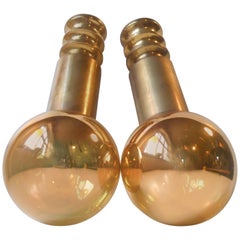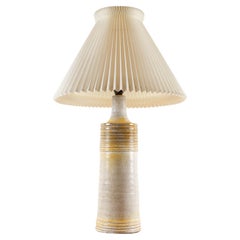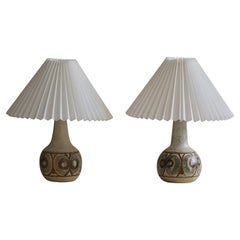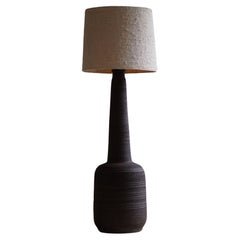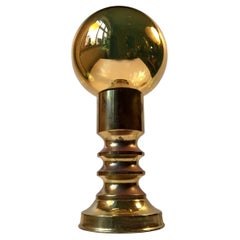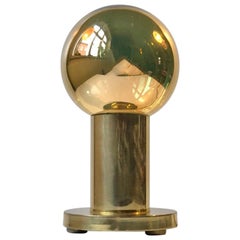Frimann Lighting
to
2
2
Height
to
1
1
1
1
2
2
2
1
2
2
2
2
2
2
1
1,434
1,202
1,076
1,065
Creator: Frimann
Pair of Midcentury Frimann Pendant Lights with Golden Everlasting Bulbs 'G126'
By Frimann
Located in Esbjerg, DK
Rare pair of Frimann Goldstar pendant lamps manufactured by Philips in the 1970s. Both mounted with original bulbs from the period - claimed to be everlasting. An additional feature ...
Category
1970s Danish Mid-Century Modern Vintage Frimann Lighting
Danish Modern Ceramic Frimann Table Lamp, 1970s
By Frimann
Located in Asaa, DK
Danish Modern Ceramic Frimann table lamp, 1970s
Tall ceramic lamp in earth colors with yellow accents. Fitted with original pleated Le Klint shade.
Makers mark on socket.
E26/27
...
Category
1970s Danish Scandinavian Modern Vintage Frimann Lighting
Materials
Ceramic
Related Items
Danish Modern, A Pair of Ceramic Table Lamps, Earthern Tones, By Søholm, 1970s
By Søholm Stentøj
Located in Odense, DK
A beautiful pair of organic shaped stoneware table lamps. Made by Søholm in Denmark, in the 1970s.
Both table lamps are in great condition. A beautiful set well suited for the Modern...
Category
Mid-20th Century Danish Mid-Century Modern Frimann Lighting
Materials
Stoneware, Ceramic
Tall Decorative Organic Ceramic Lamp, Danish Midcentury, 1970s
Located in Odense, DK
A rare tall Danish Mid-Century Modern brutalist stoneware lamp in a beautiful vintage condition. Dark earthen colors. Crafted in Denmark in the 1970s.
A beautiful vintage lamp well ...
Category
Mid-20th Century Scandinavian Scandinavian Modern Frimann Lighting
Materials
Ceramic
Pair of French Golden Crystal Orb Pendants
Located in New York, NY
A wonderful pair of 1960s French golden solid polished brass round disc fixture with 16 solid glass orbs. Five-light sources which emit light downward through the glass as well as u...
Category
1960s French Mid-Century Modern Vintage Frimann Lighting
Materials
Brass
Søholm, Table Lamp, Stoneware, Denmark, 1970s
Located in High Point, NC
A blue-glazed stoneware table lamp designed and produced by Søholm Keramik, Bornholm, Denmark, c. 1970s.
Dimensions of Lamp (inches): 8.25“ H x 3.375“ Diameter
Dimensions of Shade ...
Category
1970s Danish Scandinavian Modern Vintage Frimann Lighting
Materials
Stoneware
Pair of ceramic table lamps, Italy, 1970s
By Søholm Stentøj
Located in Stockholm, SE
Produced in Italy, 1970s. Good original condition.
Category
1970s Swedish Scandinavian Modern Vintage Frimann Lighting
Materials
Stoneware
Pink Shaded Scandinavian Modern Glazed Ceramic Table Lamp, 1970s
Located in Esbjerg, DK
Stylish 1970s onion shaped ceramic table light decorated in earthy green, blue, black and brown glazes set in an organic abstract pattern on a creamy main-glaze. It was made in Denma...
Category
1970s Danish Scandinavian Modern Vintage Frimann Lighting
Materials
Ceramic, Textile
Turquoise Ceramic Table Lamps, 1970s
By Hoppy Chang
Located in Den Haag, NL
Very nice Turquoise color lamp stands. Square shape. Comes with matching shades.
Signed. 1970s. Measures: Without shades. Height 30 cm, width 10 cm, depth 10 cm. one E27 bulb.
With...
Category
1970s Chinese Chinese Chippendale Vintage Frimann Lighting
Materials
Ceramic
Ceramic Table Lamp Germany 1970s
By West German Pottery
Located in Antwerp, BE
Modern 1970s brown and white glazed ceramic table lamp consisting of a square ceramic base on which the ceramic globe with lighting articulated and illuminate any desired direction.O...
Category
1970s German Mid-Century Modern Vintage Frimann Lighting
Materials
Ceramic
Noomi Backhausen Danish Modern Erika Table Lamp, 1970s
By Noomi Backhausen, Søholm Stentøj, Poul Brandborg
Located in Copenhagen, DK
Handmade and hand painted Danish mid-century modern stoneware table lamp by designers Noomi Backhausen and Poul Brandborg for Danish Søholm Stentøj. Petite lamp with a glazed cat lik...
Category
Mid-20th Century Danish Mid-Century Modern Frimann Lighting
Materials
Stoneware, Ceramic, Pottery
Midcentury German VEB Industrial Iron and Aluminium Pendant with Edison Bulb
By VEB Leuchten
Located in Leicester, Leicestershire
Iron and aluminium ceiling pendant with glass cover by VEB of Germany.
Reclaimed from Industrial settings then professionally restored in the UK ready for use in modern interiors....
Category
1970s German Industrial Vintage Frimann Lighting
Materials
Aluminum, Steel
Pair of Orrefors Pendant Lights
By Carl Fagerlund, Orrefors
Located in London, England
Stunning pair of mid-century Swedish crystal pendant lights by Orrefors. Textured crystal shades give off a fantastic effect when illuminated. Re-wired and tested.
H 58cm x W 17cm x ...
Category
1960s Swedish Mid-Century Modern Vintage Frimann Lighting
Materials
Crystal, Brass
Danish Ting Keramik Modern Ceramic Lamp, 1970s
Located in Copenhagen, DK
Handmade, hand-decorated Danish Mid-Century Modern stoneware table lamp attributed to designer Henning Rasmussen. Incised organic decor around the top in warm and dark brown colors. Warm beige variegated glaze with a green tint. Lower part with clear glaze allowing the raw ceramic material to show. Manufactured in the tiny Danish village of Følle by Ting Keramik...
Category
Mid-20th Century Danish Mid-Century Modern Frimann Lighting
Materials
Ceramic, Stoneware, Pottery
Previously Available Items
Scandinavian Modern Brass Table Lamp with Everlasting Bulb by Frimann, 1960s
By Frimann
Located in Esbjerg, DK
Frimann table light with original golden everlasting mirror Jumbo bulb - E27 socket. Please notice that the light of this type of bulb is not meant to lid up the room but create a co...
Category
1960s Danish Mid-Century Modern Vintage Frimann Lighting
Materials
Brass
Vintage Danish Spy-Ball Table Lamp in Brass from Frimann, 1970s
By Frimann
Located in Esbjerg, DK
This 'Spy Ball' table lamp was designed and manufactured in the early 1970s by the Danish Design Company Frimann. Featuring a Philips Goldstar 126 everlasting Bulb, the golden bulb r...
Category
1970s Danish Scandinavian Modern Vintage Frimann Lighting
Materials
Brass
Scandinavian Midcentury Brass and Opaline Pendant Lamp from Frimann, 1960s
By Frimann
Located in Esbjerg, DK
This Frimann hanging Light is fashioned out of brass and opaline glass. It was manufactured and designed by Frimann in Denmark during the 1970s. The style is reminiscent of Hans-Agne...
Category
1960s Mid-Century Modern Vintage Frimann Lighting
Materials
Brass
Midcentury Mirror Ball Pendant Lamp from Frimann, 1960s
By Frimann
Located in Esbjerg, DK
This is a Frimann hanging light with original golden everlasting mirror jumbo bulb - E27 socket. Please note that the light of this type of bulb is not meant to lid up the room but c...
Category
1960s Mid-Century Modern Vintage Frimann Lighting
Materials
Brass
Danish Spy-Ball Brass Table Lamp from Frimann with Goldstar 126 Everlasting Bulb
By Frimann
Located in Esbjerg, DK
This 'Spy Ball' table lamp was produced in the early 1970s by the Danish Design-Company Frimann. Featuring a Philips Goldstar 126 everlasting Bulb, the golden bulb reflects its surro...
Category
1970s Danish Mid-Century Modern Vintage Frimann Lighting
Materials
Brass
Frimann lighting for sale on 1stDibs.
Frimann lighting are available for sale on 1stDibs. These distinctive items are frequently made of ceramic and are designed with extraordinary care. There are many options to choose from in our collection of Frimann lighting, although brown editions of this piece are particularly popular. Many of the original lighting by Frimann were created in the Scandinavian Modern style in scandinavia during the 1970s. If you’re looking for additional options, many customers also consider lighting by Vitrika, Lyskaer, and Belysning. Prices for Frimann lighting can differ depending upon size, time period and other attributes — on 1stDibs, these items begin at $727 and can go as high as $749, while a piece like these, on average, fetch $738.
